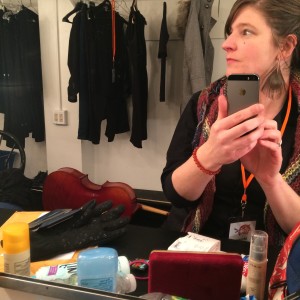This post was originally published at Pyragraph and is reposted here with kind permission.

A year ago I quit my day job. It was easy to make the announcement and write the first part of my story, because I was excited! However, writing this follow-up has been a lot more challenging.
A little background: The day-job I quit was part-time. It was secure and it complimented my creative career as a musician and poet. So, I was conflicted about leaving. However, I knew that if I stayed any longer, I would never take the chance to see what was behind the other door—the door that led to working on music and writing exclusively, the door that led to me working as a freelancer and calling my own shots. I was miserable with the thought of never knowing what that would feel like.
For various reasons, the clock was ticking. If I was going to jump, it had to be now.
How did I prepare for this? I talked to other full-time musicians and I crafted a business plan. Then, I seriously talked my five-fold business plan over with at least a dozen people, as well as a representative at Seattle Small Business Association. I got green lights. I created an active teaching studio. Also, I became a Certified Clinical Musician (someone who plays particular therapeutic styles of music at the bedside of the sick and dying). The plan was that the day job hours would be taken over by therapeutic work, more or less. Since putting my plan into practice, I still think it’s solid in theory, but several factors beyond my control caused a certain amount of failure.
An important nuance I’ve had to take note of is seasonal fluctuations in work. I have wedding gigs in the summer, but not many students. This past year has shown moments of good fortune—touring with amazing musicians to New York with the successful show, Now I’m Fine—contrasted by disappointments when efforts don’t pay off—I did an intense two-day trade show for state healthcare workers expecting to drum up new clinical music work, but got empty leads, which left me physically and mentally drained.
There have been lots of challenges this first year on my own, but they’ve only pushed me to try something new and get comfortable with making mistakes when they happen.
New things I’ve tried this year and succeeded at:
- Recording original tunes in studio and at home (in progress)
- Making a music video
- Bartered harp lessons for other needed services
- Led healing harp tones guided meditation workshop
Fallen short:
- Getting 3-5 therapeutic music accounts (I’ve succeeded so far at only gaining two)
- Rejected grants
Future goals:
- Skype harp lessons
- Self-publishing a multi-instrument album
- Leading more group workshops
- More therapeutic music accounts
In one year’s time, I’d say I’m not as rosey-eyed, that is, I may not have taken into account how the highs and lows are much more extreme, which can be more exciting and more scary. Yet still, I’m optimistic by nature, so I always have that working to my advantage. I am very comfortable with turning down offers that are not respectable or reciprocal. I also happen to live in a wealthy city, where there are many resources for artists and people who will pay for artistic services.
My choice to work freelance has really been about my need to fulfill a dream. In his poem, “Harlem,” Langston Hughes asks:
What happens to a dream deferred?
Does it dry up
like a raisin in the sun?
Or fester like a sore—
And then run?
I knew my dreams would lose their strength, or worse yet, cease to exist, if I didn’t answer to their calling. That is what this career choice has been about, because working in the arts is more than just “making a living,” it’s a lifestyle. I like seeing where the mystery unfolds, even if it’s a little terrifying. It’s my path and I own it.